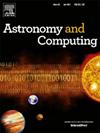基于多阶段机器学习的大质量恒星Hα线风参数估计方法
IF 1.8
4区 物理与天体物理
Q2 ASTRONOMY & ASTROPHYSICS
引用次数: 0
摘要
本文提出了一种多阶段估计大质量恒星领域风参数的方法。我们使用来自ISOSCELES数据库δ-slow解的Hα非旋转合成光谱线来训练基于高斯混合模型的聚类方法和深度神经网络分类器。然后,将观察到的Hα线轮廓进行反卷积并分类为一类,该类提供了等腰线中定义的线轮廓的简化子集。这使我们能够准确、快速地识别所选子集内最近的线轮廓,并获得风参数:v∞和Ṁ。与传统方法相比,该多阶段方案大大减少了确定风参数所需的计算时间,并提供了更准确和客观的结果。这项工作的有趣结果包括评估12个b -超巨星样本的方法,在谱线轮廓的拟合方面提供了显着的改进,因为它允许更好地近似天鹅座P谱线的形状,包括吸收和发射。本文章由计算机程序翻译,如有差异,请以英文原文为准。
A multi-stage machine learning-based method to estimate wind parameters from Hα lines of massive stars
This work presents a multi-stage method for estimating wind parameters in the domain of massive stars. We use the H non-rotating synthetic spectral lines from the ISOSCELES database’s -slow solutions to train a Gaussian Mixture Model-based cluster method and a deep neural network classifier. Then, the observed H line profiles are deconvolved and classified into a class that provides a reduced subset of line profiles defined in ISOSCELES. This allows us to accurately and rapidly identify the closest line profile within the selected subset and obtain the wind parameters: and . Compared to traditional methods, this multi-stage proposal significantly reduces the computation time required to determine the wind parameters and gives more accurate and objective results. Interesting results of this work include evaluating the method for a sample of 12 B-supergiants, offering a notable improvement in the fitting of the line profiles, as it allows for a better approximation of the shape of the P Cygni lines for both components, absorption, and emission.
求助全文
通过发布文献求助,成功后即可免费获取论文全文。
去求助
来源期刊

Astronomy and Computing
ASTRONOMY & ASTROPHYSICSCOMPUTER SCIENCE,-COMPUTER SCIENCE, INTERDISCIPLINARY APPLICATIONS
CiteScore
4.10
自引率
8.00%
发文量
67
期刊介绍:
Astronomy and Computing is a peer-reviewed journal that focuses on the broad area between astronomy, computer science and information technology. The journal aims to publish the work of scientists and (software) engineers in all aspects of astronomical computing, including the collection, analysis, reduction, visualisation, preservation and dissemination of data, and the development of astronomical software and simulations. The journal covers applications for academic computer science techniques to astronomy, as well as novel applications of information technologies within astronomy.
 求助内容:
求助内容: 应助结果提醒方式:
应助结果提醒方式:


